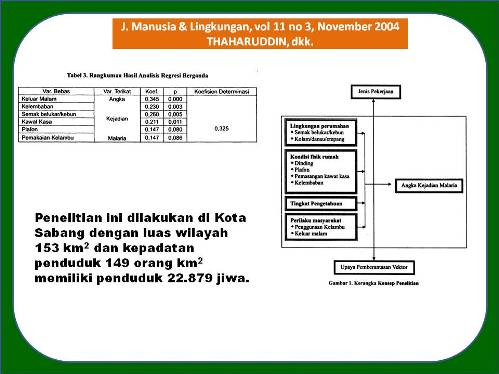
LINGKUNGAN PERUMAHAN, KONDISI FISIK, TINGKAT PENGETAHUAN, PERILAKU MASYARAKAT DAN ANGKA KEJADIAN MALARIA DI KOTA SABANG (Housing Environment, Physical House Condition, Knowledge, Behaviour and Number of Malaria Occurrence in Sabang)
Thaharuddin Thaharuddin(1*), Soeyoko Soeyoko(2), Adi Heru Sutomo(3)
(1) Dinas Kesehatan Provinsi Nanggroe Aceh Darussalam
(2) Fakultas Kedokteran Universitas Gadjah Mada
(3) Fakultas Kedokteran Universitas Gadjah Mada
(*) Corresponding Author
Abstract
ABSTRAK
Malaria merupakan persoalan kesehatan dunia yang belum terpecahkan di Indonesia. Malaria merupakan penyakit yang meluas terjadi baik di pegunungan maupun di dataran rendah di perkotaan dan di perdesaan. Penelitian ini mengkaji hubungan antara lingkungan perumahan, kondisi rumah dan pengetahuan penghuni dengan tingkat kejadian malaria di Sabang, Aceh. Penelitian ini dilakukan dengan survai investigasi. Objek survei adalah 61 penduduk yang terkena malaria dan 61 penduduk yang tidak terkena malaria sebagai control group. Variabel bebas dalam penelitian ini adalah kondisi rumah termasuk taman dan kolam air, kondisi fisik rumah dan kelembabannya. Pengetahuan serta perilaku responden terhadap malaria juga merupakan variabel yang dikaji dalam penelitian ini. Analisis yang dilakukan meliputi uji hipotesis, analisis deskriptif dan analisis regresi berganda. Hasil penelitian menunjukkan bahwa aktifitas di luar, kelembaban rumah, semak-belukar berkorelasi dengan insiden malaria.
ABSTRACT
Malaria is one of infectious disease which currently remains the world’s health problems. In Indonesia, malaria is categorized as infectious disease has, infected in all islands, either in upland or lowland, and in urban or rural areas. There found 80 species of Anopheles mosquito in this country and the predominant vector or malaria in the province of Nanggroe Aceh Darussalam is Anopheles sundaicus. This research identifies to the correlation between the housing environment, house condition, and the residents relevant knowledge with the rate of malaria incident in Sabang. The study is an analytical survey investigation employing a case control design. The investigation is conducted in Sabang. Subjects are determined using total sampling of 61 infected population (cases) and 61 malaria-free population (control group). The analysis was conducted to test the research hypothesis, consisting of descriptive analysis and multiple regression analysis. The results show that going out at night, humidity of the house, bushes/garden, and installation of gauze are all significantly correlated (p<0.01) to the rate of malaria incident in Sabang.
Full Text:
ARTIKEL LENGKAP (PDF) (Bahasa Indonesia)Article Metrics
Refbacks
- There are currently no refbacks.
Copyright (c) 2017 Jurnal Manusia dan Lingkungan







